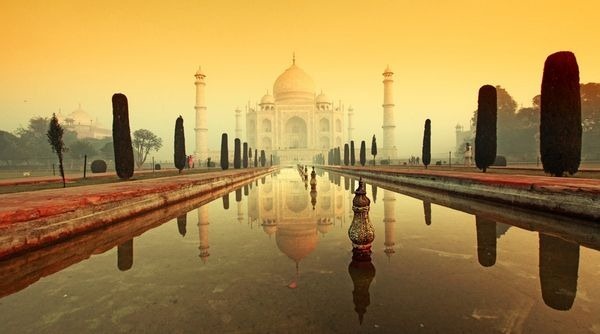


Following the recent Sikkim standoff and the finger-pointing between China and India, the Chinese public and media outlets have once again taken notice of their long-neglected neighbor, with many experts calling for a better understanding of India’s current power.
“India’s [power] should be assessed dialectically. It would be wrong to prettify or look down on our neighbor. Instead, we should objectively analyze India’s pros and cons,” Lin Minwang, a professor at the Institute of International Studies of Fudan University, told Xiakedao, a public WeChat account operated by the People’s Daily.
According to Lin, China might be the most unpopular country in the eyes of many Indians. Most elites in India hold negative opinions of China, while the public is simply indifferent to their rising neighbor.
The hostile feeling is mutual. According to a poll conducted by the Pew Research Center in 2016, in the wake of Sino-Indian territorial disputes and growing economic competitions, about six-in-ten Chinese (61 percent) hold a negative opinion of India, while 36 percent of Indians voice an unfavorable view of China, as they are concerned about the competitive strategic challenge posed by China.
In response to such deep misunderstanding between the two nations, experts in China suggest that both the public and the authorities should analyze India’s national conditions and its power objectively, adding that such practice can be beneficial for solving the current disputes.
India’s disadvantage
“In terms of economic development, India can be counted as a leading power. Compared to China, India’s manufacturing industry only accounts for over 20 percent of its economy. The reason is that in the 1980s, while China focused on its opening policy and economic reform, India attached more importance to its service industry,” said Lin.
According to experts, India’s failure in promoting its manufacturing industry has led to a serious trade deficit with China. In 2016, the total trade volume between China and India was around $70 billion, a number that was even less than that between China and Vietnam. Experts said that India does not have much that China needs, while China’s products are more welcomed by Indian market.
“It’s too late for India to develop its manufacturing industry. The trend is AI, so the need for manpower will decline. Under such circumstances, India’s huge population may become less an advantage and more a factor that undermines the country’s social stability, as a low employment rate may occur,” Lin added.
“Some people believe that India will surpass China in the long run, as India is a democratic country. But after years of development, India has lagged behind even further. Though India’s economy can grow, its development may stop when it surpasses Japan to become the world’s third largest economy, as many of its social problems will occur by then,” Lin said. “The reason why China can realize its modernization swiftly is because its society was reshaped completely and there was no historical burden for its development, but India preserves its original social formation, which has significantly blocked its way to modernization.”
A strong rival
Despite India’s disadvantage in terms of economy, the country’s military capability and overseas talent pools are some strong points that China should not ignore, said experts.
“It’s hard to evaluate India’s military power, as the country has not fought any war in the past few decades. But India’s weaponry is quite good, as both Russia and U.S. have sold it better weapons and equipment than to China. As the world’s biggest importing country of weaponry, India has good ties with those countries,” Lin said.
In addition to its advanced weaponry, oversea Indians are more united than Chinese. According to Lin, a statistics showed that among 50 scientists who seem likely to one day win the Nobel Prize, 20 of them are from India. Indian occupation in the Silicon Valley has also shown that the country enjoys great overseas talent pools.
 Fire brigade in Shanghai holds group wedding
Fire brigade in Shanghai holds group wedding Tourists enjoy ice sculptures in Datan Town, north China
Tourists enjoy ice sculptures in Datan Town, north China Sunset scenery of Dayan Pagoda in Xi'an
Sunset scenery of Dayan Pagoda in Xi'an Tourists have fun at scenic spot in Nanlong Town, NW China
Tourists have fun at scenic spot in Nanlong Town, NW China Harbin attracts tourists by making best use of ice in winter
Harbin attracts tourists by making best use of ice in winter In pics: FIS Alpine Ski Women's World Cup Slalom
In pics: FIS Alpine Ski Women's World Cup Slalom Black-necked cranes rest at reservoir in Lhunzhub County, Lhasa
Black-necked cranes rest at reservoir in Lhunzhub County, Lhasa China's FAST telescope will be available to foreign scientists in April
China's FAST telescope will be available to foreign scientists in April "She power" plays indispensable role in poverty alleviation
"She power" plays indispensable role in poverty alleviation Top 10 world news events of People's Daily in 2020
Top 10 world news events of People's Daily in 2020 Top 10 China news events of People's Daily in 2020
Top 10 China news events of People's Daily in 2020 Top 10 media buzzwords of 2020
Top 10 media buzzwords of 2020 Year-ender:10 major tourism stories of 2020
Year-ender:10 major tourism stories of 2020 No interference in Venezuelan issues
No interference in Venezuelan issues
 Biz prepares for trade spat
Biz prepares for trade spat
 Broadcasting Continent
Broadcasting Continent Australia wins Chinese CEOs as US loses
Australia wins Chinese CEOs as US loses